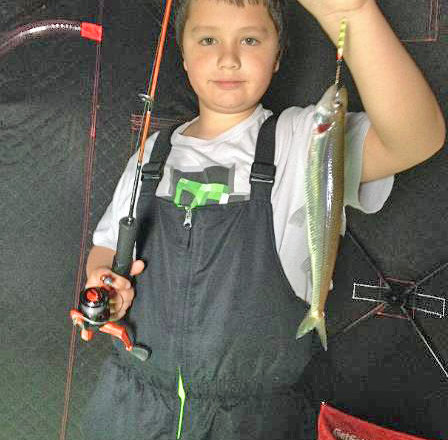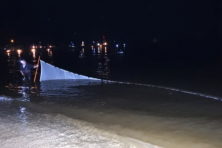Nine-year-old Catches Record Smelt
- Share
- Tweet
- Pin
- Share

As proud father Dave Derusha explains it, one of the great things about fishing on Lake Superior’s Chequamegon Bay is that you never know quite what you’ll catch.
Some days it might be coho salmon or brown trout, other days possibly walleye, northern pike or splake. And then there are the rainbow smelt.
On one late winter day this year, Derusha and his son Tanner, age 9, were jigging through the ice with slender spoons resembling young perch. The two had already caught a number of smelt, which typically run about 7 to 8 inches, when Tanner felt a slightly stronger tug on the end of his line.
“We had already been catching some of the biggest smelt I’d ever seen in my life,” Dave Derusha said. “You can always tell when you have a smelt on the line because they really flutter around. They’re actually quite exciting to catch on a light jigging rod.”
When Tanner hauled his fish up through the ice and placed it in the bucket, father and son both had reason to get excited when they noticed the smelt was quite a bit bigger than the others. The fish measured 10½ inches long and weighed almost one third of a pound!
“It really was exceptionally large for a smelt, so I pulled out my phone and started checking the internet to see what the record was,” Derusha said. “I also made a couple of phone calls from inside our pop-up shelter and eventually realized there wasn’t a Wisconsin record category for rainbow smelt. I thought, well, if Michigan has one, Wisconsin should too. So we went ahead and got it weighed and notorized and submitted it. DNR was extremely helpful through the process.
“If somebody gets a bigger smelt next month or next year, well so be it,” Derusha added. “Nobody can take away our great memory.”
Karl Scheidegger, who coordinates the Wisconsin Department of Natural Resource’s state record fish program, said the Derushas’ experience proves that age and hours on the water don’t always matter when it comes to catching record fish. Wisconsin’s productive lakes, rivers and streams continue to generate new records in a variety of categories involving anglers of all ages.
“Heading into this year’s general inland season fishing opener on May 6, Wisconsin anglers have every reason to be optimistic,” Scheidegger said. “Based on our spring fisheries surveys, we know there are some big fish out there. While our state record musky dates to 1949 and our state record walleye goes all the way back to 1933, records are made to be broken and we’re seeing it happen with many species.”
Starting on opening day, this year anglers also will have the opportunity to submit fish for a new live release record category. The program aims to provide anglers with the win-win satisfaction of achieving a state record and a successful live release. Scheidegger said the new program is part of a larger effort to promote quality fishing and encourage the careful release of trophy-size popular sport species. Similar efforts have found success in other states and among some national record-keeping organizations.
To learn more about DNR’s new live release record category, search dnr.wi.gov for “live release.” Instructions for a harvest record can be found by searching “record fish.”


